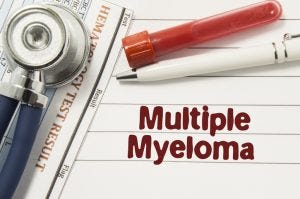
J&J has reported a 57% year-on-year growth for its multiple myeloma monoclonal antibody Darzalex (daratumumab) and is now hoping to increase adoption through a subcutaneous formulation.
For its second quarter 2019, Johnson & Johnson clocked in sales of $10.5 billion (€9.4 billion) in its pharmaceutical division, up 4.4% on the same period last year.
The firm attributed this to several of its biological products, not least Darzalex (daratumumab) which grew 57% year-on-year to pull in $774 million in global sales. The monoclonal antibody was first approved in November 2015 for multiple myeloma, and has since received approval for related indications, including in combination with other drugs.

Image: iStock/Shidlovski
Joaquin Duato, vice chairman of the Executive Committee at J&J, said he is “pleased with the progression” of Darzalex across all lines of therapy on a call with investors, adding the approval in June in combination with Celgene’s Revlimid (lenalidomide) will give the drug three indications in frontline treatments.
Subcutaneous formulation
“As we move into earlier lines, the duration of the treatment increases,” he said. As such, the firm filed for a subcutaneous (SC) formulation of Darzalex earlier this week. If approved, the formulation will substantially reduce infusion time for patients “from eight hours that we have today to five minutes,” Duato said, and thus drive future sales.
“That’s going to give significant advantages in terms of adoption of Darzalex… particularly when you think that 50% of the use of Darzalex today in the US is in oncology clinics in outpatient patients,” he said.
“So we think that this combination is going to make Darzalex easier to use for physicians, more convenient to patients. If you add to that the number of studies in which we are showing very strong results in front line will pertain for a very positive continue adoption of Darzalex that we see one of the major drivers of the growth of the Pharmaceutical Group.”
The subcutaneous formulation consists of Darzalex with recombinant human hyaluronidase PH20 (rHuPH20), which uses Halozyme’s ENHANZE drug delivery technology.
The enzyme works by locally degrading Hyaluronan (HA), a naturally occurring glycosaminoglycan, in the extracellular matrix at the subcutaneous injection site, increasing large volume subcutaneous delivery.
The technology has been approved in subcutaneous formulations of Roche’s Herceptin (trastuzumab), Rituxan (rituximab) and Takeda’s Hyqvia [Immune Globulin Infusion 10% (Human) with Recombinant Human Hyaluronidase].
About the Author
You May Also Like

schedl_b_and_w.jpg?width=100&auto=webp&quality=80&disable=upscale)
schedl_b_and_w.jpg?width=400&auto=webp&quality=80&disable=upscale)


